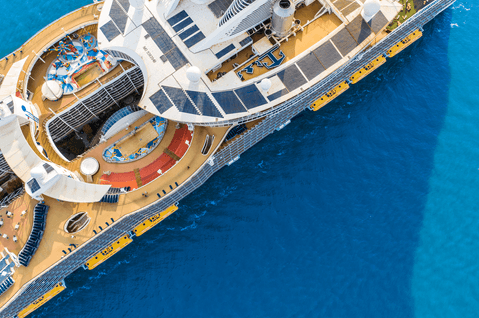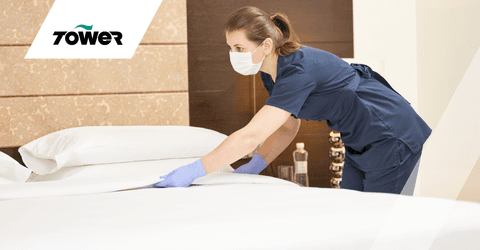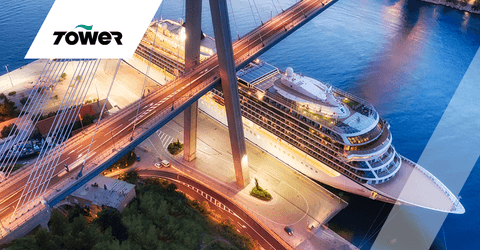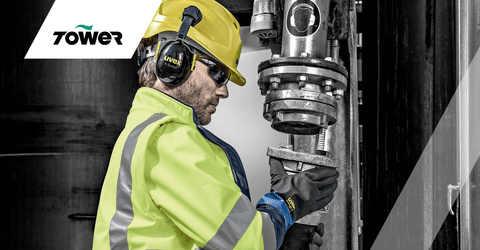
Looking at some of the most important types of PPE for those working on cruise ships. Including technical and hotel operations.
We've been working with the cruise industry for decades. So we understand the need for equipment that keeps workers safe at sea. Personal safety is a top priority, as having the most effective forms of PPE could save lives on your ships. With experience in every aspect from back-of-house protective clothing to engine room PPE, you know you're working with a trusted supplier that delivers expert advice as well as PPE.

PPE for cruise ships is divided into two categories: technical equipment and hotel operation. Technical equipment refers to PPE used by staff working on maintaining the ship. Hotel operations refers to the staff which take care of and interact with the holidaymakers on board. Both sets of workers require PPE unique to their roles.
Working in the integral parts of the ship requires a combination of head protection, body, eye, and foot protection. Specialised equipment includes fire-resistant coveralls for work in engine rooms and extreme weather gear for working outside in rough conditions, where a safety harness may be required.
Hotel operations include front-of-house and back-of-house staff. And they all require their own kind of protective equipment focused on hygiene and general safety. They may be required to wear face masks or gloves for hygiene purposes, and even non-slip shoes.

We understand that PPE on cruise ships covers a wide variety of employees. We know the differences in working environments, and the risks faced by everyone from engineers to kitchen staff.
Our unrivalled knowledge in multiple sectors and extensive range of equipment, PPE, workwear, and equipment, means you only need Tower as your supplier to buy everything from coveralls to welding helmets.
Coveralls protect the body from hazardous substances such as hot water or a welding spark. This makes it one of the most common pieces of protective clothing and is a standard item of protective clothing for crew members.
Coveralls are typically worn by the onsite maintenance crew, engineers, and welders to protect against sparks. Hi-vis coveralls may also be worn if a worker is at risk of injury in low visibility environments.
Safety shoes help workers find and keep their footing safely, preventing slips and fall. This is essential in an environment where machinery and cargo take up most of the internal space of the ship.
Foot protection is required when workers are at risk of injury such as objects falling on or damaging toes. Crew members who handle generators, move machinery, or operate winches could be required to wear safety shoes.
Hand protection is used for many daily jobs on a cruise ship. Gloves are worn to protect the hands from risk of injury. Like other forms of PPE, hand protection needs to meet particular standards.
The industry standard ensures workers are provided with the correct hand protection for their roles. Some examples include heat-resistant gloves, cotton gloves for normal operation, as well as welding or chemical-resistant gloves.
As the eyes are the most sensitive part of the body, eye protection is necessary when your work might put them at risk. Common eye injuries include cuts and scrapes to corneas due to forging objects and chemical damage.
Always provide the correct eye protection. This could include safety goggles for employees working with harsh cleaning chemicals or welding goggles for welders making repairs.

This is used to prevent headaches, irritation, or hearing loss in an engine room, which can produce 110-120 dB of sound. Areas should contain warning signs and should not be entered without required ear defenders or ear plugs.
Working on a ship means you can be at risk of other head-related injuries. Some of the most devastating injuries in the maritime industry are to the head. Hard hats or helmets guard against life-changing head injuries.
Cruise ship employees working as welders, painters, and sandblasters are exposed to hazardous particulates such as asbestos or silica dust. Respirators can help prevent injury or lung-related illness related to these environments.
As chemicals are frequently used onboard ships, they can be very dangerous, especially when in contact with skin. Chemical suits or hazmat suits are often used to protect against harm from chemicals found in cleaning.
Cruise ships have difficult areas to access or reach, and the risk of falling from height is quite high. A safety harness is a type of safety equipment and is essential when routine maintenance is conducted at height on a ship.
As ships can require structural repairs even on the move, it’s important to have a welder on hand. Welders must be provided with a welding shield or mask to protect eyes from the light produced while welding.
Speak to one of our subject matter experts to find out what PPE or workwear you need on your cruise ship. For further information fill out the form below or call us on 01202 718000.
Discover how Tower can support your cruise ship with sustainable cleaning and more.